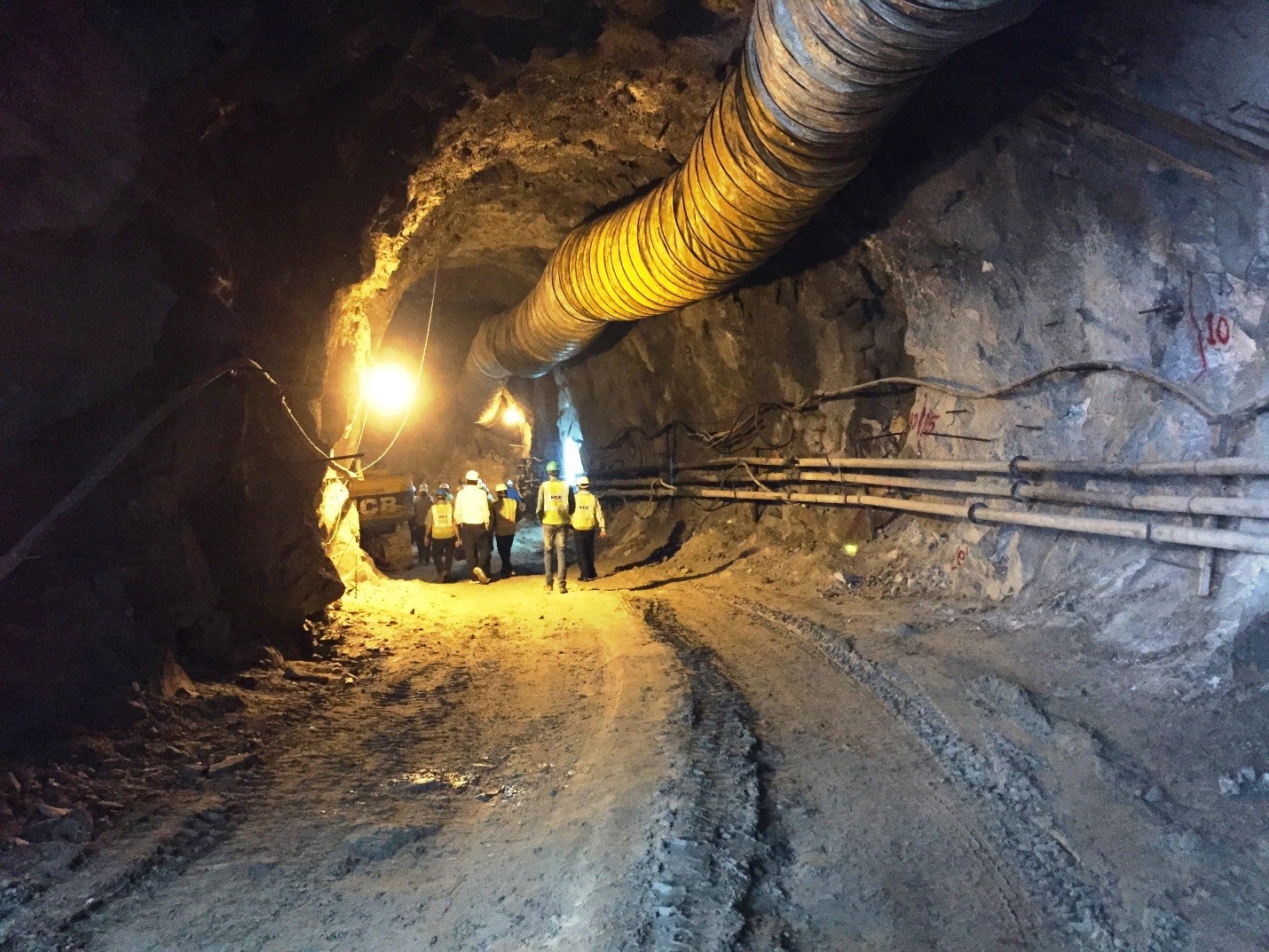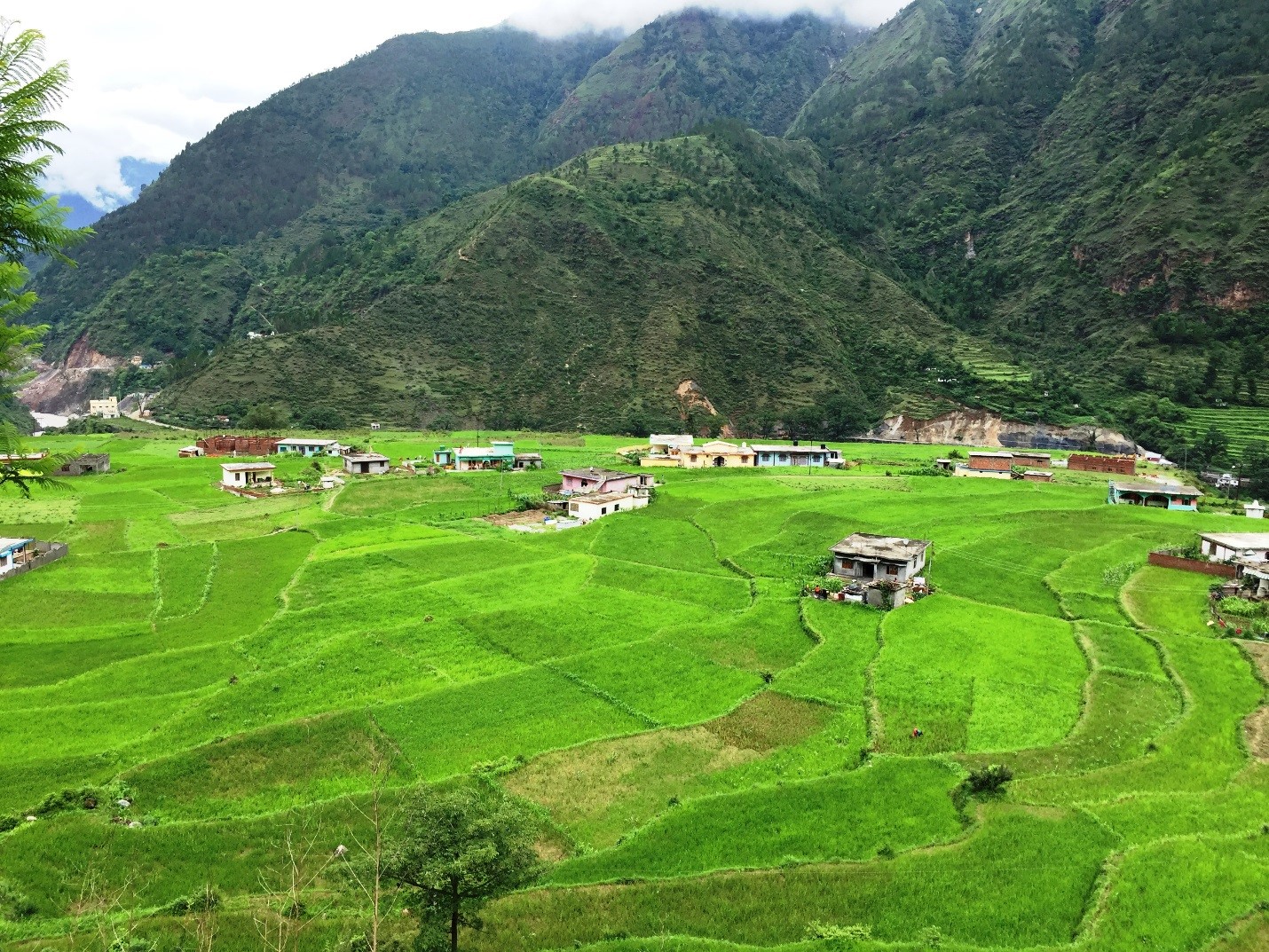As a run-of-river project, VPHEP has comparatively limited land acquisition impacts. The project will require a total of 141.57 ha of land comprising 31.64 ha of private land, 90.09 ha of government forest/grazing land, 10.3 ha of van panchayat land, and 9.54 ha of state land owned by the Public Works Department. The acquisition of private land affects seven villages, while the remaining 11 project-affected villages will lose access only to government forest/grazing and/or van panchayat land.
Apart from these land affected families, another 1500 households are affected only by reduced access to grazing and the collection of fodder and fuel from government and van panchayat land (community held grazing and forest land) that the project will be taking over.
A total of 265 families will be resettled under the project, and of these 92 percent are families from the village Haat, where the powerhouse is to be located. They had proposed their land for acquisition by THDCIL, and expressed an interest in relocating to the other side of the river, which is considered more desirable in view of the proximity to the highway, markets, schools etc. Even though most of the land that the people of Haat offered was not required by the project, THDCIL agreed to this proposal in the interest of minimizing the disturbance to the village.
Land Acquisition and Resettlement & Rehabilitation (R&R): The project has acquired all the privately-owned land (31.64 ha) it will need. Out of 558 titleholders, compensation has been paid to 505. Some 802 families were eligible to also receive R&R assistance. Of these, 682 families (85% of the total) have received their dues; the process is underway for another 120 families from Haat; about 70 families are either not available or their claims is yet being verified by the state government. THDCIL has, so far, paid out Rs 75.47 million towards R&R assistance.
Relocation Progress of Haat Village:
The villagers of Haat have begun building their new houses across the river, with facilitation from THDCIL. So far 69 families have completed the construction of their new houses on the left bank of the river at sites in Daswana, Eldana, Mayapur and Agthala villages, in keeping with the agreed relocation plan for Haat. Fifty Eight families have already moved into their new homes.
As of July 2015, out of previously identified 70 eligible households from Haat, 59 households had received the first installment of the special grant of Rs 1 million and, 57 have received the second installment, while 18 households have received the third and final instalment as well. The third instalment is provided when the individual’s old house in Haat village is vacated.
THDCIL is in the process of setting up the community infrastructure for these new settlements. Eldana is already connected to the highway and THDCIL plans to link Daswana village to the national highway by a road via Garhi village to be constructed by the state Public Works.
Both the relocation sites of Daswana and Eldana have been linked to sources that watered their original village, Haat. Supplementary water tanks have also been installed at both locations to ensure adequate supply especially during the summer. Electricity supply to houses has been connected and THDCIL has provided street-lights for the new settlements. The primary school for the communities is currently run from a rented building; THDCIL is constructing a new school building in El Dana which will be ready by the end of 2015.
Other facilities that will also be provided include panchayat ghars at Daswana and El Dana, a baraat ghar and an anganwaadi. THDCIL has also opened a dispensary at their site office which is open for these communities.
The Hamlet of Hatsari: When the village of Haat chose to relocate, eight families in the hamlet of Hatsari within Haat opted not to relocate. In order to limit the land acquisition impacts on Hatsari, THDCIL altered the project design and shifted the location of the switchyard from Hatsari to already acquired government forest land, and also realigned an access road. In its present design, the project requires no land from Hatsari. However, in the interest of minimizing the disturbance to these families of Hatsari during the construction period, THDCIL would prefer to facilitate their relocation, if only on a temporary basis, on terms equal to those to which the majority of the residents of Haat agreed. Negotiations with these families at Hatsari are ongoing.
Fuel & Fodder Allowance: THDCIL will compensate villagers for loss of access to community forestlands that it will be acquiring for the Project. So far project has disbursed INR 19.38 million to 1,262 households across 15 villages. THDCIL has decided to increase the annual compensation from INR 10,000 to INR 15,600 from the third year of disbursement onward.
Insurance of Houses: In response to concerns voiced by villagers about the possible imapcts of tunneling on their houses, THDCIL has decided to insure all structures that fall within a 500 metre corridor along its two major tunnels, the head race tunnel and the tailrace tunnel. The visual documentation of these structures has been completed and THDCIL will soon be signing the insurance policy.
Employment Opportunities: THDCIL has required the contractor to ensure that 70 percent of its workforce be recruited locally (according to eligibility and criteria based on level of impacts). THDCIL is also giving hiring preference to qualified local candidates as and when appropriate openings emerge on its own staff. THDCIL and the contractor have, to date, provided employment to 97persons from the project area. Moreover, an additional 306 have got indirect employment or benefits through the hiring of their vehicles, leasing of their houses or lands etc.
Livelihood Restoration: In order to ensure that the livelihoods of local people are not adversely affected by the project, THDCIL has also drawn up an Income Restoration Plan for project-affected persons. Under this, the Company has assisted the affected villages to form 21 co-operative societies which undertake small community infrastructure works like road repairs, building bunds and gabion walls etc. of value up to Rs 200,000.
THDCIL is also helping project affected persons get vocational training in various trades such as motor mechanics, marketing, hospitality. The company is also collaborating with the Industrial Training Institute (ITI) at nearby Gopeshwar to ensure that 20 percent of seats in this institution are guaranteed for youths from families affected by VPHEP. The ITIs at Rudraprayag and Srinagar have also been requested to provide short term courses in areas related to the hydropower industry so that trainees can be absorbed in various hydro projects upon completion of their training. Till July 2015, some 185 persons have been trained in different trades.
Other income restoration schemes include distribution of high-yield seeds and fruit saplings and activities such as dairy development (in Guniyala village), vermicomposting, and napier grass cultivation. A more detailed Training Needs Assessment for individual project affected persons is to be conducted to better design individual livelihood restoration plans.
Scholarships for Students: THDCIL is providing scholarships to meritorious students from these villages to help them build career. So far, 530 students of which 285 are girl students have benefitted from these scholarships. In order to attract more meritorious students, THDCIL has increased the scholarship amount. So far project has disbursed INR 1.04 million towards scholarships
Corporate Social Responsibility: CSR activities have been planned with the involvement of community and are being regularly implemented. The community works implemented in various project-affected villages include building pathways, ropeways and drinking water schemes for these remote mountain villages. THDCIL has already spent more than Rs 28 million on these activities.
Focus on Women: The Project has also so far provided training and business opportunities to 269 women PAPs in tailoring, knitting, backyard poultry, and agricultural activities. THDCIL is planning to introduce monthly assistance scheme for widows. Under this program, each widow will be entitled for INR 1500 per month for a period of seven years. A total of 47 such widows have been identified in the project area.
THDCIL has established a Women Safety and Facilitation Centre in village Haat. The center is managed by two residents of Haat village. The purpose of the center is to monitor activities of contractor’s labour force and will also act as a first contact for any women harassed by any project worker or official. The phone number of this center has been widely circulated through pamphlets.
Grievance Redress Committee (GRC): The GRC established under the project is working well to address issues referred to it by project-affected people (PAPs). So far, 19 formal and 46 informal meetings of the GRC have taken place. Only one case has been referred to the Commissioner for Land Acquisition and Resettlement and Rehabilitation. In response to a suggestion from project-affected people the GRC will occasionally hold its meetings in project-affected villages. So as to allow people to access it more easily.
Monitoring and Evaluation (M&E): THDCIL has engaged an M&E consultant team whose quarterly reports will be available in the VPHEP Project Information Centre.
MANAGEMENT OF ENVIRONMENT IMPACTS
As project activities pick up pace, THDCIL is gearing up to ensure that the local environment is not unduly impacted. THDCIL has set up a panel of national and international-level experts to help guide them in the management of these impacts as per the project Environment Management Plan (EMP). Another level of monitoring for the EMP will be provided by third-party agencies. The contractor for the civil works will support THDCIL in the implementation of the EMP; the contract document has strict environment-related obligations laid out in it.
Muck Disposal: THDCIL has made arrangements for the effective disposal of the debris that will be generated by the excavation works. It has identified four sites and, after approval from the Uttarakhand Pollution Control Board, designated them as the areas where the muck will be delivered. The contract document for the civil works mandates the contractor to dump the debris in only these areas and to build strong retaining walls to ensure that no muck falls into the river. Following the identification by the World Bank of some gaps in the contractor’s practices, THDCIL is working with the contractor to ensure that muck-disposal is conducted according to agreed norms.
Catchment Area Treatment Plan: The Company has budgeted Rs 4.7 million for improving and restoring the river’s catchment area; this important activity will be implemented by the State Forest Department on the basis of funds provided by THDCIL. The Company will liaise closely with the Department on a detailed plan for implementation and monitoring of the CAT Plan.
Archeological Management: The Company THDCIL has engaged the Archaeological Survey of India (ASI), Dehradun, to help lead the archeological preservation and restoration management of the Laxmi Narayan temple at Haat. The team from ASI will visit the site shortly to begin the conservation works.
Monitoring: Third-party monitoring of the environmental management of the Project has begun, with the Indian Council for Forestry Research and Education (ICFRE), Dehradun, monitoring the CAT Plan works and WAPCOS monitoring the other elements of the EMP. The monitoring will cover progress on activities mandated by (a) the environment and forest clearances, (b) the conditions of the Pollution Control Board’s NOC to the project, (c) actions agreed with community during public hearings of the project, (d) ISO 14001 requirements; and (e) any other requirements identified in the bid documents. These reports will be available in the Project Information Center at site.
Construction Safety: THDCIL had the National Safety Council conduct an audit of operational health and safety practices at the project site. The recommendations for strengthening safety procedures are being taken up for action.


